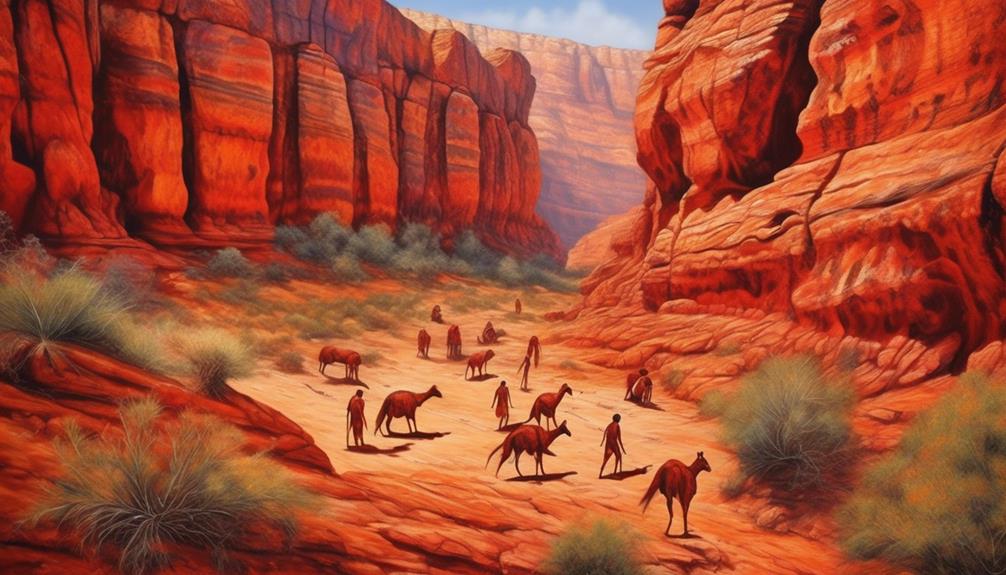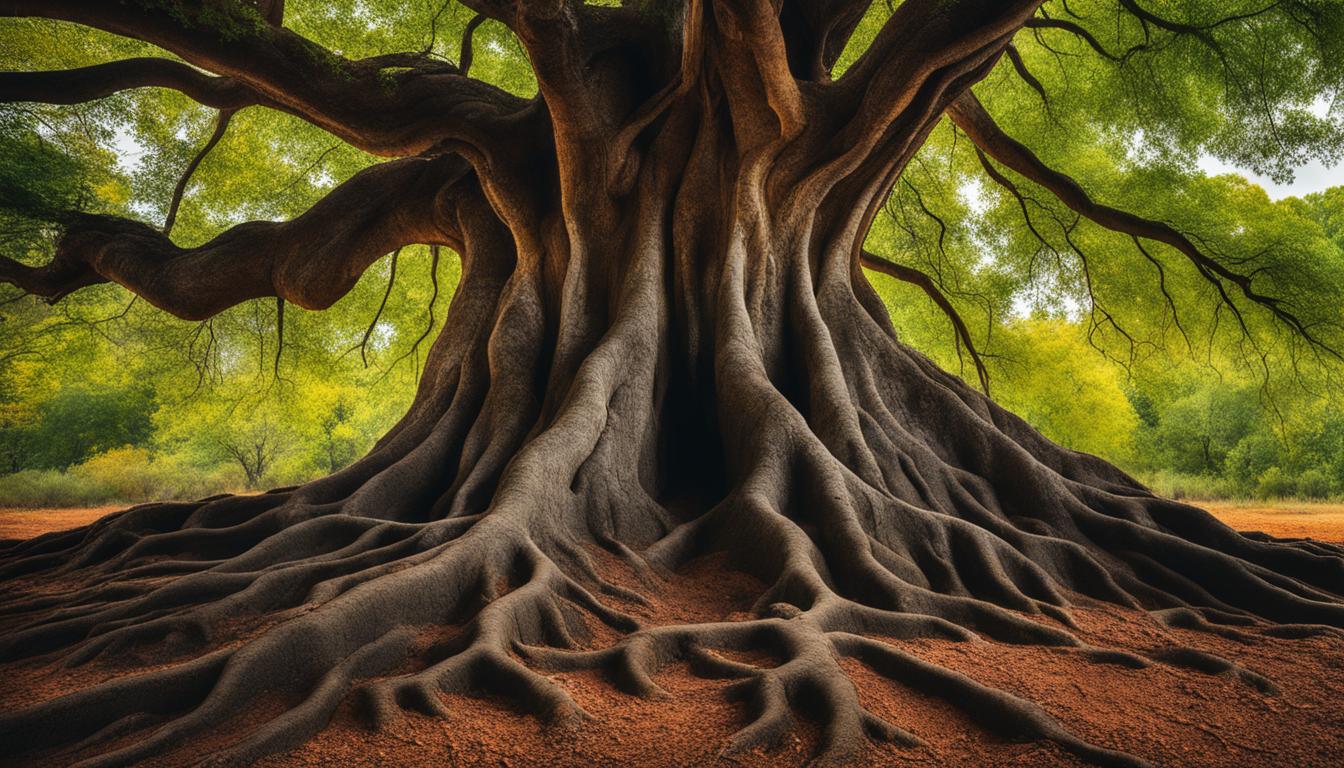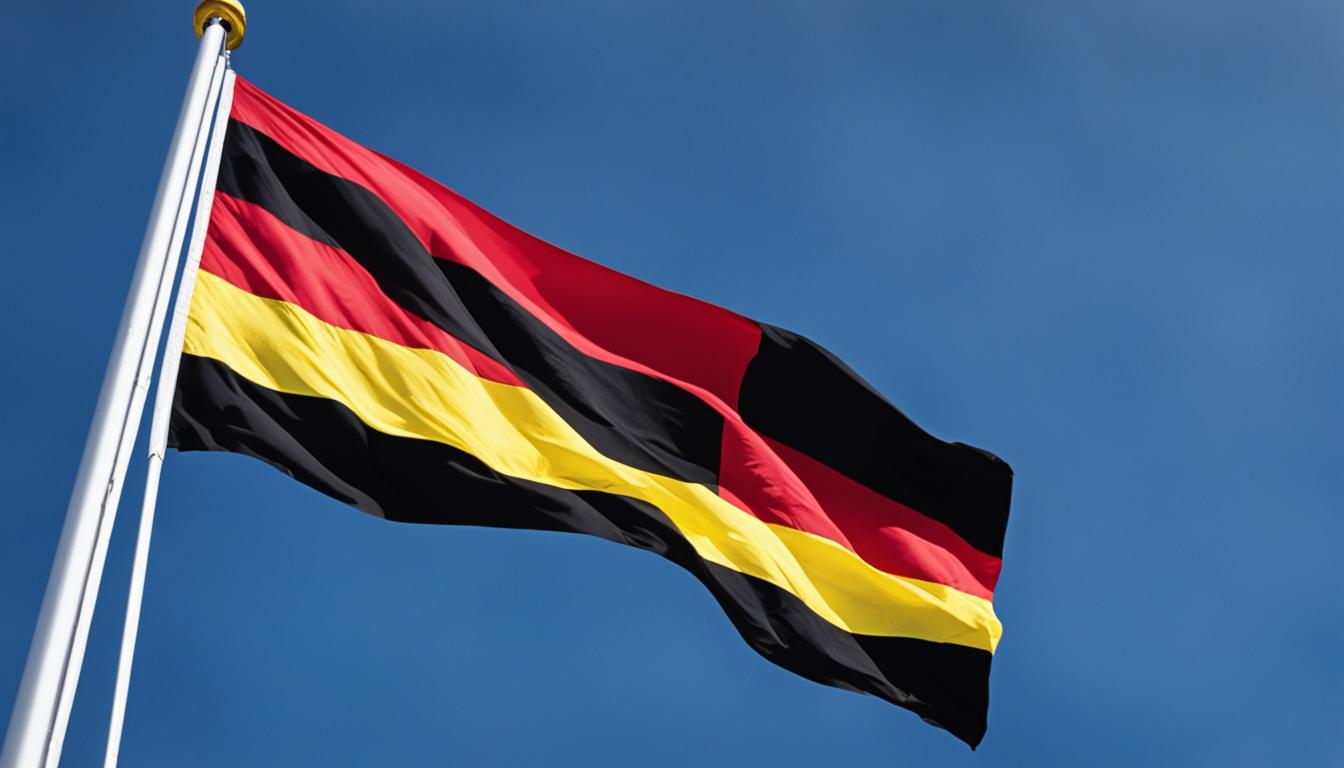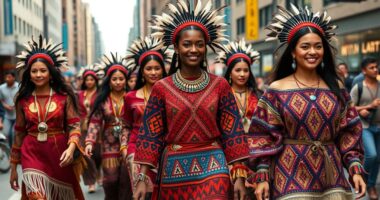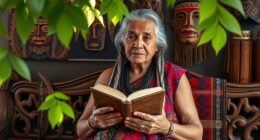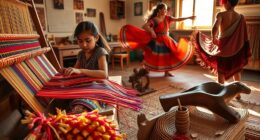When considering the wide variety of national parks in Australia, ancient Aboriginal rock paintings may not be the first thing that comes to mind. However, these natural reserves hold a hidden treasure trove of art and cultural heritage that is both fascinating and incredibly significant.
As we explore the diverse landscapes and ecosystems of these parks, we will uncover the enigmatic connection between the Aboriginal people and their ancestral lands, and in doing so, discover where these remarkable rock paintings can be found.
Key Takeaways
- Kakadu National Park, Uluru-Kata Tjuta National Park, Flinders Ranges National Park, and Purnululu National Park are some of the parks where Aboriginal rock paintings can be found.
- Aboriginal rock paintings hold immense cultural significance as they depict Dreamtime stories, creation ancestors, and the natural environment, showcasing the rich cultural heritage of the Aboriginal people.
- The rock paintings serve as a tangible link to the past and offer insights into the beliefs, rituals, and daily lives of traditional custodians, reflecting a rich cultural tapestry.
- Preservation efforts are being made in collaboration with the local Aboriginal community, incorporating traditional knowledge and expertise, utilizing non-invasive methods for documentation and monitoring, and educating visitors about the significance of rock art in order to protect and preserve these culturally significant sites.
Kakadu National Park
Kakadu National Park, located in the Northern Territory of Australia, is home to a remarkable collection of ancient Aboriginal rock paintings. These paintings hold immense Aboriginal cultural significance and provide a window into the rich cultural heritage of the Indigenous people of Australia. The traditional art techniques used in these paintings have been passed down through generations, preserving the stories and traditions of the Aboriginal people.
The rock paintings in Kakadu National Park offer a unique insight into the spiritual and cultural beliefs of the Aboriginal people. They depict Dreamtime stories, creation ancestors, and the natural environment, showcasing the deep connection that the Aboriginal people have with the land. These paintings aren't just artworks; they're a vital link to the past, present, and future of Indigenous Australian culture.
The traditional art techniques used in these rock paintings demonstrate the skill and expertise of the Aboriginal artists. These techniques often involve using natural pigments, such as ochre, and applying them to the rock surfaces using various methods, including finger painting, stenciling, and cross-hatching. The intricate designs and detailed depictions in the rock art highlight the artistic mastery of the Aboriginal people and their deep understanding of the natural world.
Visiting Kakadu National Park offers a profound opportunity to witness and appreciate the ancient art form that holds such significant cultural importance. It allows us to honor and respect the traditions and stories of the Aboriginal people while marveling at the artistic brilliance encapsulated in these rock paintings.
Uluru-Kata Tjuta National Park
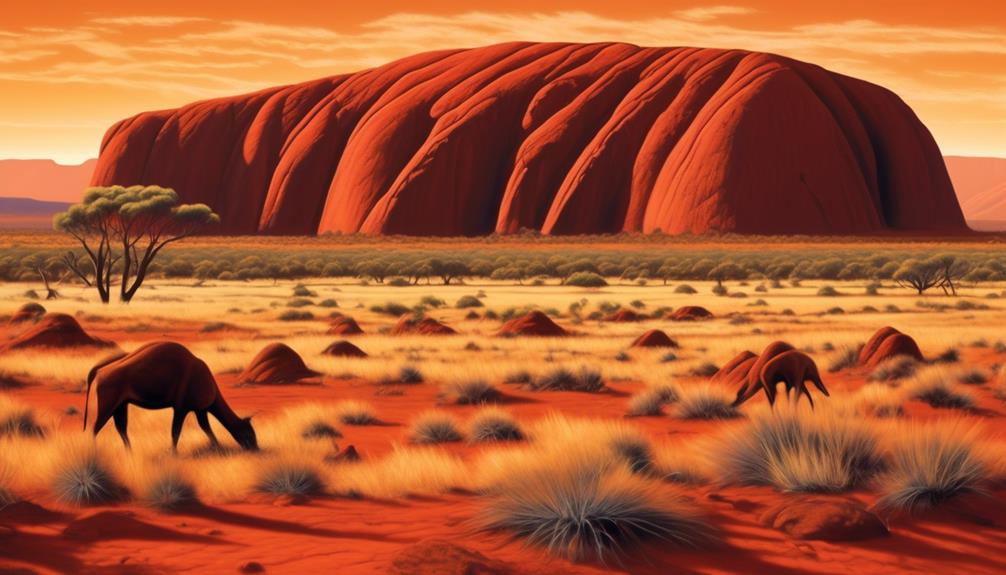
The rich cultural heritage of Indigenous Australian rock paintings continues to be showcased at Uluru-Kata Tjuta National Park, where the ancient art form provides a profound insight into the spiritual and cultural beliefs of the Aboriginal people. The park holds immense cultural significance as it's home to numerous rock art sites, some of which are believed to be over 10,000 years old. These paintings depict stories of creation ancestors, spiritual beings, and the natural environment, offering a window into the traditional knowledge and practices of the Anangu people, the traditional owners of the land.
The traditional techniques used in creating these rock paintings have been passed down through generations, using natural pigments derived from plants, ochre, and other materials. The intricate designs and vibrant colors reflect the deep connection the Aboriginal people have with the land and their profound understanding of its resources.
Preservation methods and conservation efforts at Uluru-Kata Tjuta National Park are of paramount importance to ensure the longevity of these invaluable cultural treasures. The park management, in collaboration with the Anangu traditional owners, employs various strategies such as monitoring visitor access to sensitive areas, implementing erosion control measures, and conducting regular maintenance to safeguard the rock art sites for future generations.
Visitors to the park are encouraged to respect and appreciate the significance of the rock art, and to engage with the cultural interpretation provided by the local Indigenous guides. By fostering a deeper understanding and respect for this ancient art form, we can contribute to the preservation of the cultural heritage embodied in the rock paintings at Uluru-Kata Tjuta National Park.
Flinders Ranges National Park
What fascinating cultural treasures await visitors at the Flinders Ranges National Park, and how do they connect us to the ancient history of the land?
The Flinders Ranges National Park is home to some of the most significant examples of Aboriginal art in Australia, providing a window into the cultural significance of this ancient land.
Here are four key aspects of the Aboriginal rock paintings that make this park a must-visit:
- Cultural Significance: The rock paintings in Flinders Ranges National Park aren't only beautiful works of art but also hold immense cultural significance for the Adnyamathanha people, the traditional owners of the land. These paintings depict stories of creation, important cultural practices, and the relationship between the people and the land.
- Preservation Efforts: The park authorities, in collaboration with the local Aboriginal community, have been dedicated to the preservation of these ancient artworks. Through careful conservation efforts, these rock paintings are being protected for future generations, ensuring that the rich cultural heritage they represent endures.
- Rock Painting Locations: Visitors to the park have the opportunity to see these remarkable rock paintings at several locations, including Arkaroo Rock and Yourambulla Caves. These sites not only showcase the artistic prowess of the Aboriginal people but also provide a deeper understanding of their connection to the land.
- Connection to Ancient History: The rock paintings at Flinders Ranges National Park offer a unique opportunity to connect with the ancient history of Australia, allowing visitors to appreciate the enduring legacy of the Aboriginal culture in this breathtaking landscape.
Purnululu National Park

As we shift our focus to Purnululu National Park, we're eager to explore the significance of the rock paintings and the ongoing efforts to preserve them.
The rich cultural history depicted in the rock art provides a window into the traditions and stories of the Aboriginal people who've called this land home for thousands of years.
Understanding the importance of these paintings is crucial for ensuring their protection and continued appreciation for generations to come.
Rock Painting Significance
Located within the striking landscape of Purnululu National Park, the rock paintings hold profound cultural and historical significance for the Aboriginal people. These ancient artworks are a testament to the enduring legacy of Aboriginal culture and the deep connection to the land.
The significance of the rock paintings lies in:
- Preserving Indigenous Knowledge: The art serves as a repository of traditional knowledge, depicting stories, rituals, and spiritual beliefs passed down through generations.
- Cultural Continuity: The paintings symbolize the enduring presence of Aboriginal culture and its resilience in the face of societal changes over millennia.
- Connection to Country: They represent a tangible link to the land, reflecting the intimate relationship between the Aboriginal people and their ancestral territory.
- Indigenous Culture Appreciation: By understanding and respecting these artworks, visitors can gain insight into the rich and diverse Indigenous cultures that have thrived in Australia for thousands of years.
Preservation Efforts
Efforts to preserve the culturally significant rock paintings in Purnululu National Park are an integral part of our commitment to honoring and protecting the rich heritage of the Aboriginal people. Indigenous involvement in preservation techniques is crucial to ensure the longevity of these precious artworks. We actively engage with the local Aboriginal community to incorporate their traditional knowledge and expertise in preserving and caring for these ancient paintings. Our collaborative efforts also extend to community engagement and educational programs, aiming to raise awareness and appreciation for the cultural significance of these rock paintings. Together, we work to develop sustainable preservation strategies that respect and uphold the values of the Aboriginal people. It's essential to involve and empower the community to ensure the long-term preservation of this extraordinary cultural heritage.
| Indigenous Involvement | Preservation Techniques | Community Engagement | Educational Programs |
|---|---|---|---|
| Active participation of Indigenous elders and community members | Use of non-invasive conservation methods | Encouraging local participation and awareness | Educational initiatives for visitors and schools |
Burrup Peninsula
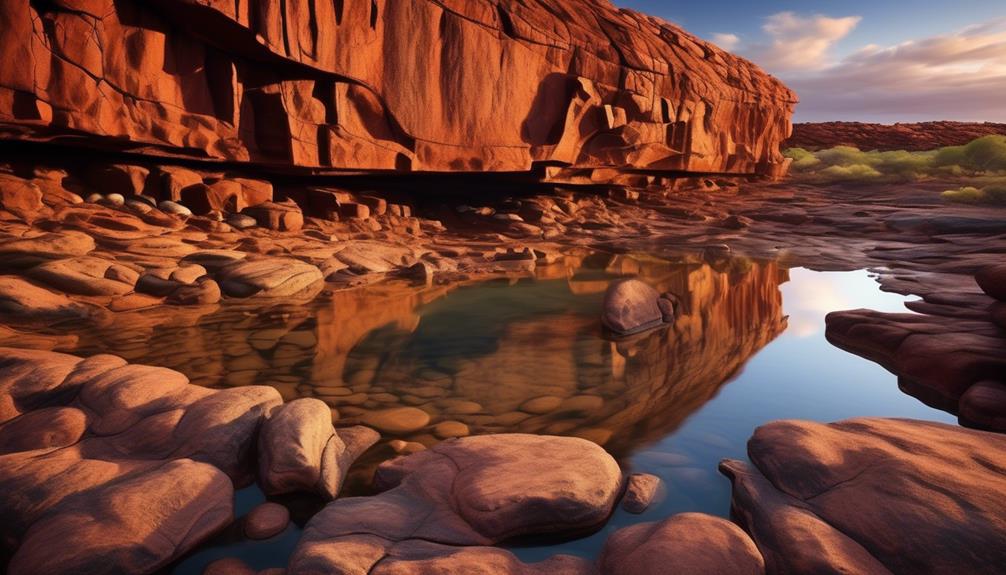
As we explore the Aboriginal rock paintings in Burrup Peninsula, it's important to recognize their cultural significance and the preservation efforts in place.
These ancient artworks provide a deep connection to the history and spirituality of the Aboriginal people, and it's crucial to respect and protect this heritage.
Cultural Significance
With deep reverence for the ancient heritage of the Burrup Peninsula, the rock paintings serve as a profound testament to the enduring cultural significance of the Aboriginal people. These paintings hold immense value, not only as a link to the past but also as a living expression of Aboriginal traditions and cultural heritage.
As custodians of this land, we acknowledge the responsibility to ensure the conservation and preservation of these invaluable treasures. The indigenous art depicted in these rock paintings reflects a deep connection to the land and a rich cultural tapestry that has withstood the test of time.
It's a privilege to witness and learn from these artworks, which continue to inspire awe and respect for the enduring legacy of the Aboriginal people.
- The rock paintings are a living expression of Aboriginal traditions and cultural heritage.
- We've a responsibility to ensure the conservation and preservation of these invaluable treasures.
- The indigenous art depicted in the rock paintings reflects a deep connection to the land.
- The paintings inspire awe and respect for the enduring legacy of the Aboriginal people.
Preservation Efforts
Amidst the rugged beauty of the Burrup Peninsula, our commitment to safeguarding the ancient rock paintings is unwavering. Indigenous involvement is integral to our conservation initiatives, as we recognize the significance of traditional knowledge in preserving these invaluable artworks. We have established a collaborative approach that combines traditional techniques with modern preservation methods. This ensures that the rock paintings are protected in a culturally sensitive manner, respecting the heritage of the indigenous communities. Our efforts also include ongoing research to develop innovative ways to mitigate environmental impact and natural deterioration. Below is a summary of our preservation efforts:
| Indigenous Involvement | Conservation Initiatives | Preservation Techniques |
|---|---|---|
| Active participation of local Indigenous communities | Implementation of protective zoning and monitoring programs | Use of non-invasive digital documentation and climate control methods |
Through these combined efforts, we aim to secure the preservation of these ancient rock paintings for future generations.
Carnarvon Gorge National Park
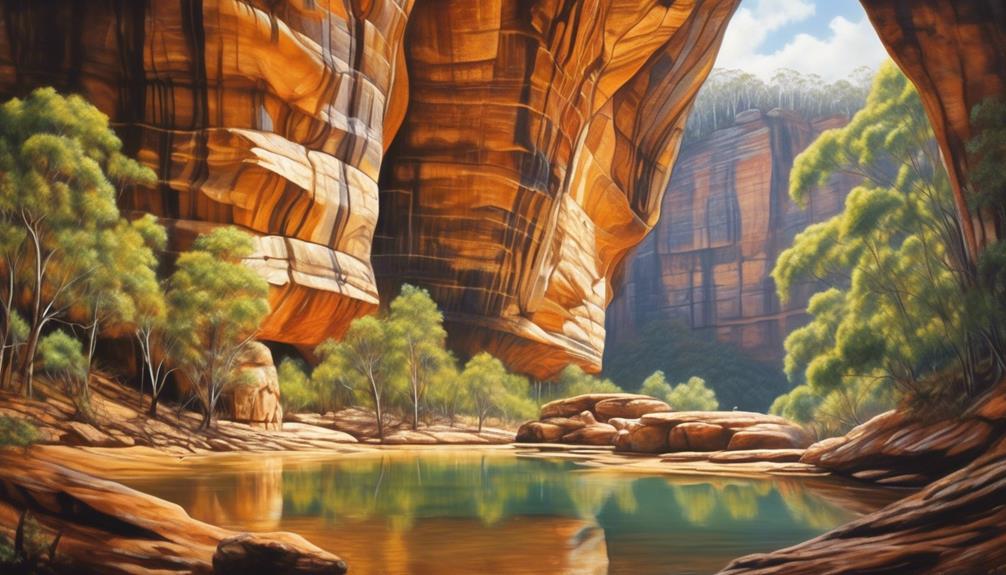
Exploring Carnarvon Gorge National Park reveals a rich tapestry of Aboriginal rock paintings that offer unique insights into the cultural heritage of the region. These ancient artworks, created by the Indigenous people who've called this land home for thousands of years, hold immense historical significance, providing a window into the traditions, beliefs, and daily lives of the original inhabitants of this area. As we wandered through the park, we were captivated by the stories depicted in the rock art, each painting a testament to the enduring connection between the Indigenous people and the land they've revered for generations.
Here are 4 fascinating aspects of the Aboriginal rock paintings at Carnarvon Gorge National Park:
- Diverse Themes: The rock paintings depict a wide range of subjects, including human figures, animals, spiritual beings, and intricate patterns, reflecting the multifaceted aspects of Indigenous life and culture.
- Cultural Preservation: These ancient artworks serve as a living record of the traditions and customs of the Aboriginal people, allowing us to gain a deeper understanding of their rich cultural heritage.
- Artistic Techniques: The skill and artistry exhibited in these rock paintings are truly remarkable, showcasing the creativity and craftsmanship of the Indigenous artists who contributed to this extraordinary legacy.
- Spiritual Significance: Many of the rock art sites are considered sacred by the local Indigenous communities, underscoring the spiritual importance of these locations and the enduring cultural practices associated with them.
Visiting Carnarvon Gorge National Park offers a profound opportunity to appreciate and honor the Indigenous art and heritage that enriches this breathtaking landscape.
Limmen National Park
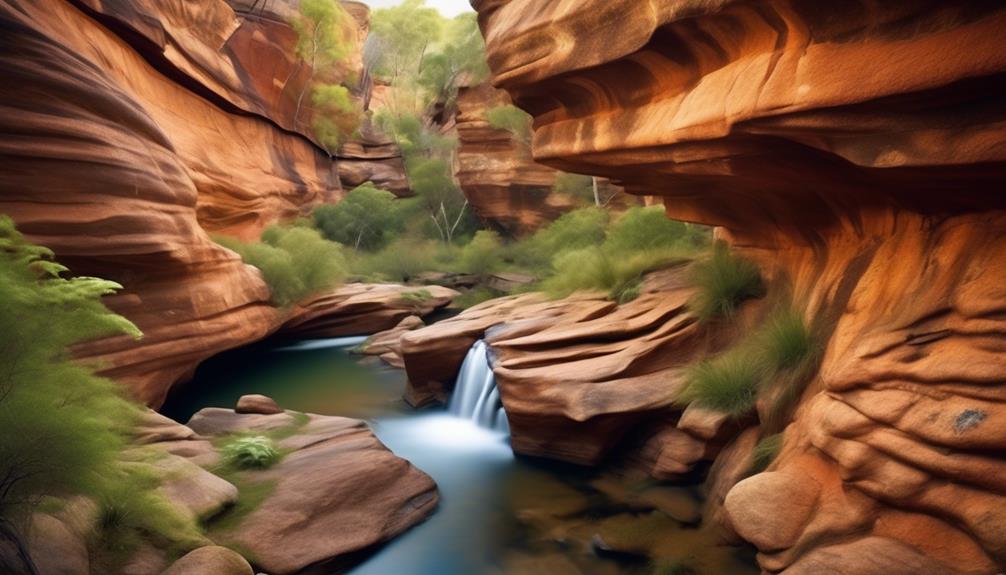
Nestled within the rugged beauty of the Northern Territory, Limmen National Park beckons with its untouched landscapes and promises of remarkable encounters with Aboriginal rock art. As visitors, we're privileged to witness the enduring legacy of the Indigenous peoples in the form of rock art that adorns the park's ancient rock formations. This significant cultural heritage is a testament to the deep connection that the Indigenous communities have with this land.
Rock art preservation is of utmost importance in Limmen National Park. The custodians of this land, the Indigenous traditional owners, have been instrumental in the preservation efforts. Their traditional knowledge and practices are crucial in ensuring that these delicate and ancient artworks are protected for future generations. The park management also plays a vital role in collaboration with the Indigenous communities to safeguard and conserve these invaluable cultural expressions.
Indigenous heritage protection is a central aspect of the management and conservation strategies in Limmen National Park. It involves not only the physical preservation of the rock art but also the promotion of understanding and respect for the stories and traditions behind the art. As visitors, we've the responsibility to engage with the rock art in a respectful and culturally sensitive manner, honoring the living culture from which it stems.
Limmen National Park stands as a testament to the enduring legacy of the Indigenous peoples and the ongoing efforts towards rock art preservation and Indigenous heritage protection. As visitors, it's our privilege to immerse ourselves in this rich tapestry of history and culture while respecting and honoring its significance.
Dampier Peninsula
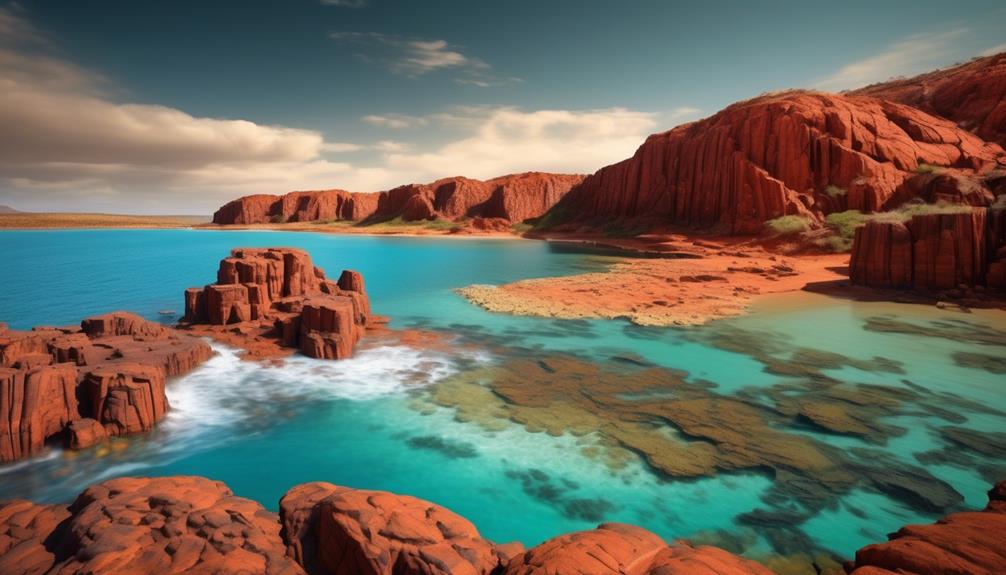
Continuing our exploration of Aboriginal rock art and cultural heritage, we now turn our attention to the captivating Dampier Peninsula in the Northern Territory. This region is a treasure trove of Indigenous culture and traditional art, offering a glimpse into the rich history and artistic traditions of the Aboriginal people.
Here are some fascinating aspects to consider when delving into the Aboriginal rock art of the Dampier Peninsula:
- Rich Cultural Significance: The Dampier Peninsula holds deep cultural significance for the local Aboriginal communities, with rock art sites serving as important repositories of traditional knowledge and spiritual beliefs.
- Diverse Artistic Styles: The rock art found on the Dampier Peninsula showcases a diverse range of artistic styles, reflecting the different cultural practices and artistic expressions of the Indigenous groups that have inhabited the region for thousands of years.
- Stories and Symbolism: Each rock painting and engraving tells a story, often depicting dreamtime narratives, ancestral beings, and important events in the history of the local Indigenous communities. These artworks are imbued with symbolic meanings that are integral to the cultural identity of the Aboriginal people.
- Preservation Efforts: Efforts are underway to preserve and protect the rock art of the Dampier Peninsula, ensuring that future generations can continue to appreciate and learn from these invaluable expressions of Indigenous heritage.
Exploring the rock art of the Dampier Peninsula provides a profound opportunity to engage with the living culture and artistic traditions of Australia's First Nations peoples.
Wollemi National Park

As we explore Wollemi National Park, it's essential to highlight the significant locations of ancient rock paintings, their cultural significance, and the ongoing efforts to preserve these invaluable historical treasures.
These rock paintings provide a window into the rich traditions and stories of the Aboriginal people, offering us a deeper understanding of their heritage and connection to the land.
Rock Painting Locations
Located within Wollemi National Park are several significant sites showcasing ancient Aboriginal rock paintings that offer a glimpse into the rich cultural history of the indigenous people. These rock paintings provide a window into the rock painting techniques and Aboriginal storytelling traditions.
Here are four remarkable locations within Wollemi National Park where you can find these captivating rock paintings:
- Colo Meroo: This site features a collection of rock shelters adorned with vibrant rock art, depicting various aspects of Aboriginal life and spiritual beliefs.
- Wheeny Creek: Here, you can explore rock overhangs adorned with striking paintings that narrate important stories and traditions of the local Aboriginal people.
- Newnes Plateau: This area boasts an array of rock art, including hand stencils, animal depictions, and intricate patterns, offering insight into the diverse artistic styles of Aboriginal cultures.
- Dharug National Park: Within this part of the Wollemi National Park, you can discover ancient rock art sites that showcase the enduring connection of the Dharug people to the land through their art.
Cultural Significance
The cultural significance of Wollemi National Park is deeply rooted in the ancient traditions and spiritual connections of the Aboriginal people. This is evident from the remarkable rock paintings found throughout the park, which serve as more than just artworks. They are a living record of cultural practices and historical significance.
These paintings provide a tangible link to the past, offering insights into the beliefs, rituals, and daily lives of the traditional custodians of this land. They hold immense value as a place where these practices and traditions were carried out for thousands of years, leaving an indelible mark on the landscape.
It is crucial to approach these sites with respect and reverence, recognizing their importance in preserving and understanding the rich cultural heritage of the Aboriginal people.
Preservation Efforts
Preserving the rich cultural heritage of Wollemi National Park is a vital endeavor that requires ongoing commitment and collaboration. As custodians of this land, we're dedicated to employing effective preservation techniques and fostering community involvement to protect the Aboriginal rock paintings for future generations.
Here are some of the strategies and initiatives we're implementing:
- Utilizing non-invasive methods for documentation and monitoring to minimize any impact on the rock paintings.
- Engaging local Aboriginal communities in the preservation efforts, respecting their cultural knowledge and expertise.
- Conducting regular maintenance and conservation work to safeguard the rock paintings from environmental degradation.
- Educating visitors about the significance of the rock art and encouraging responsible tourism practices to ensure its long-term preservation.
Blue Mountains National Park
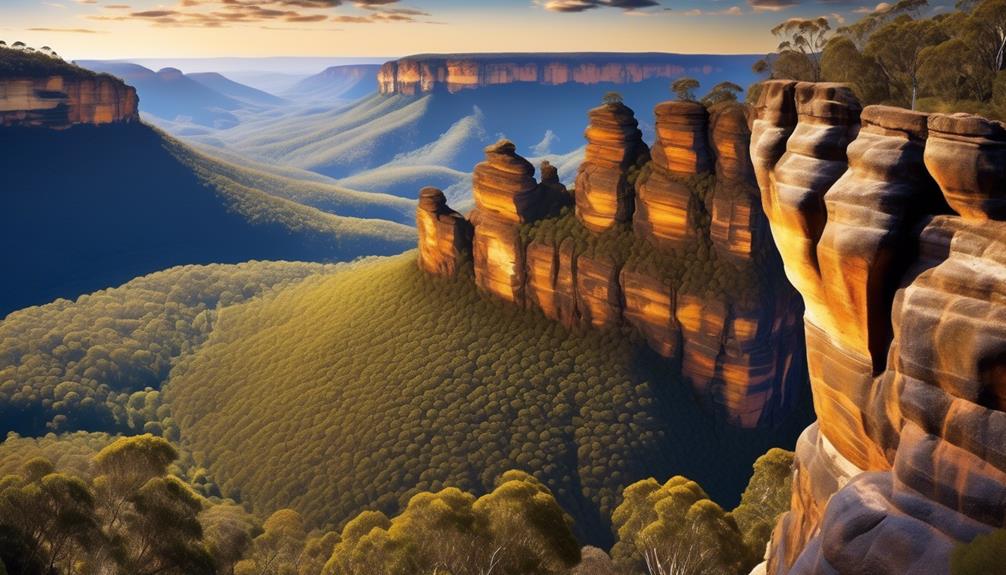
Nestled within the breathtaking Blue Mountains National Park are ancient Aboriginal rock paintings that offer a profound insight into the rich cultural heritage of the indigenous people. These remarkable artworks, estimated to be thousands of years old, are a testament to the deep connection the Aboriginal people have with this land.
The Blue Mountains hold significant spiritual and cultural importance for the local indigenous communities, and the rock paintings serve as a tangible link to their ancestors and their enduring traditions.
The presence of these ancient rock paintings underscores the importance of preserving indigenous culture within the Blue Mountains National Park. Conservation efforts are crucial to safeguarding these invaluable historical and cultural treasures for future generations. Park authorities and indigenous groups work collaboratively to ensure that these rock art sites are protected from environmental degradation, vandalism, and other threats. Through careful management and education, there's a concerted effort to raise awareness about the significance of these sites and to promote respect for indigenous heritage.
Visitors to the Blue Mountains National Park have the opportunity to engage with the rich indigenous culture and gain a deeper understanding of the spiritual and artistic traditions expressed in the rock paintings. It's a privilege to witness these ancient artworks and to appreciate the enduring legacy of the Aboriginal people, whose connection to this land spans millennia.
Ku-ring-gai Chase National Park

Exploring the Ku-ring-gai Chase National Park, one encounters another remarkable showcase of ancient Aboriginal rock paintings, continuing the journey of understanding and appreciating the enduring cultural legacy of the indigenous people in this region.
The park not only offers stunning natural beauty but also serves as a living testament to the rich Indigenous heritage and artistic expression of the Aboriginal people.
Here are a few captivating aspects that make the Ku-ring-gai Chase National Park a significant site for experiencing the ancient Aboriginal rock paintings:
- Diverse Rock Art Sites: The park is home to a wide variety of rock art sites, each offering a unique glimpse into the artistic expression and cultural practices of the Aboriginal people who've inhabited this land for thousands of years.
- Spiritual and Cultural Significance: The rock paintings serve as a powerful reminder of the deep spiritual and cultural connections that the Aboriginal communities have with the land, providing insights into their belief systems and way of life.
- Preservation Efforts: Efforts to preserve and protect these ancient artworks are ongoing, with initiatives aimed at safeguarding the rock paintings for future generations to appreciate and learn from.
- Educational Opportunities: Visitors have the opportunity to engage in educational programs and guided tours that provide valuable context and understanding of the significance of the rock art, fostering greater respect and appreciation for Indigenous heritage and artistic expression.
The Ku-ring-gai Chase National Park stands as a testament to the enduring legacy of the Aboriginal people, offering a profound and enriching experience for those seeking to connect with Australia's ancient cultural heritage.
Arnhem Land
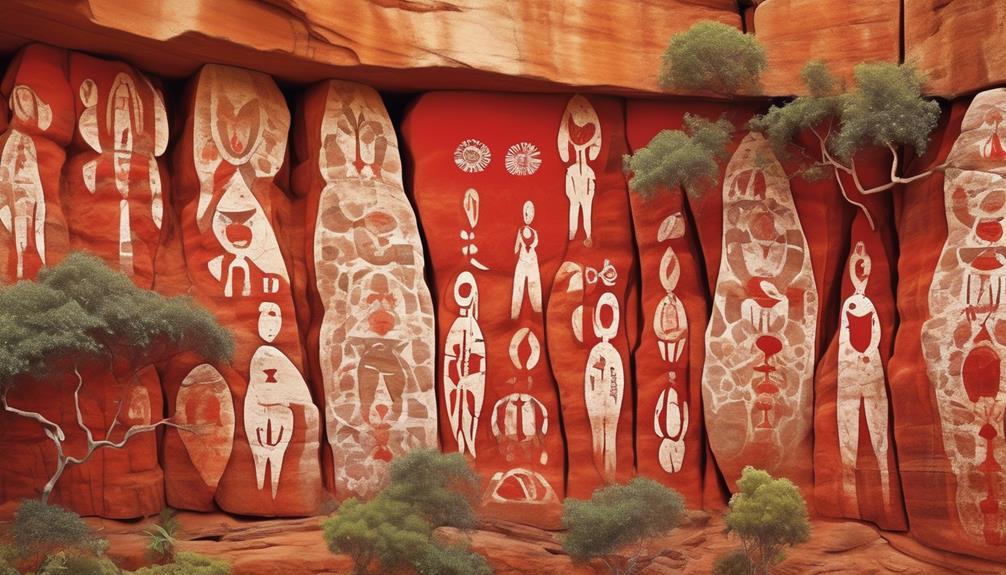
Arnhem Land provides a captivating insight into the rich cultural heritage of the Indigenous people, showcasing an extraordinary array of ancient Aboriginal rock art sites. The preservation techniques employed in Arnhem Land are crucial in safeguarding these invaluable cultural treasures.
Traditional art techniques, such as using natural pigments derived from plants and minerals, have been passed down through generations and continue to be utilized in creating and maintaining these remarkable rock paintings.
The preservation techniques in Arnhem Land are a testament to the deep respect and reverence the Indigenous communities have for their cultural heritage. Through methods like regular monitoring, documentation, and controlled visitor access to the rock art sites, the traditional custodians ensure that these ancient paintings are protected from environmental degradation and human interference.
Furthermore, the traditional art techniques employed in creating these rock paintings are awe-inspiring. The intricate designs, vibrant colors, and the meticulous application of natural pigments display the exceptional skill and artistic prowess of the Aboriginal people. These traditional art techniques not only contribute to the visual splendor of the rock art sites but also serve as a living link to the rich cultural traditions of the Indigenous communities in Arnhem Land.
Frequently Asked Questions
What Is the Significance of Aboriginal Rock Paintings in These Parks?
The significance of Aboriginal rock paintings in these parks lies in their cultural heritage and the preservation of their stories and traditions.
Conservation efforts are crucial to maintain these historical artworks. They offer invaluable insights into the rich history and traditions of the Aboriginal people, serving as a testament to their enduring presence and connection to the land.
These paintings are a vital part of Australia's cultural landscape and deserve our utmost respect and protection.
Are There Any Restrictions or Guidelines for Visitors Wanting to View the Rock Paintings?
Visitor guidelines are in place to ensure the preservation of the rock paintings. Conservation efforts are a top priority, so visitors must adhere to strict guidelines.
These include:
- Staying on designated paths
- Refraining from touching the paintings
- Not using flash photography
Additionally, it's important to respect the cultural significance of the site and follow any specific rules set by the local indigenous community.
How Have the Local Aboriginal Communities Been Involved in the Preservation of These Rock Paintings?
In preserving these rock paintings, the local Aboriginal communities have played a vital role. Their involvement in conservation projects and educational programs has been instrumental in ensuring the cultural significance of the paintings is respected.
They've also actively contributed to visitor regulations, ensuring that these sacred sites are treated with reverence. It's truly inspiring to witness their dedication to preserving and sharing this invaluable part of their heritage.
Are There Any Ongoing Research or Conservation Efforts to Protect These Rock Paintings?
We are actively involved in ongoing research and conservation efforts to protect these invaluable rock paintings.
Our team collaborates closely with local Aboriginal communities to ensure that these efforts are guided by their knowledge and expertise.
We continuously seek innovative approaches and technologies to safeguard these historical treasures for future generations.
Our commitment to this preservation work is unwavering, and we're dedicated to honoring and respecting the cultural significance of these rock paintings.
Can Visitors Participate in Any Educational Programs or Tours to Learn More About the Aboriginal Rock Paintings in These Parks?
Visitors can engage in educational programs and tours to delve into the cultural significance of the Aboriginal rock paintings. Interpretation sessions provide a deep understanding of the art's historical and spiritual context.
These experiences foster a respectful connection to the land and its traditional custodians. Through these initiatives, visitors gain a mastery of the rich indigenous heritage, creating a more inclusive and knowledgeable appreciation of the rock art.
Conclusion
After exploring these amazing parks, we can confidently say that Kakadu National Park, Uluru-Kata Tjuta National Park, and Burrup Peninsula are the places to go for incredible Aboriginal rock paintings.
These ancient artworks provide a window into the rich history and culture of Australia's indigenous peoples.
So, grab your gear and head out to these stunning parks to witness these mesmerizing anachronisms for yourself.
Happy exploring!
Mary is a passionate writer who brings creativity and a fresh perspective to our team. Her words have the power to captivate and inspire, making her an essential contributor to our content. Mary’s commitment to storytelling and dedication to promoting Indigenous culture ensures that her work touches the hearts of our readers. We’re fortunate to have her as part of our team.
